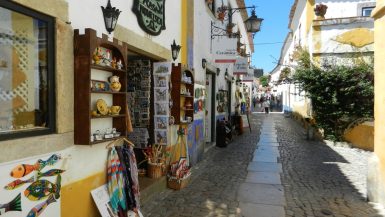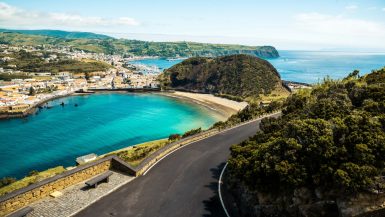
If you’re wondering how to travel between Azores Islands, then you’ve come to the right place. This guide will delve into the ins and outs of getting from A to B in this eye-wateringly wonderful Portuguese archipelago, all to help you plan that perfect jaunt that includes the top hikes, the most dramatic beaches, and the most culture-rich towns.
There are only two ways to get between different islands in the Azores archipelago: By boat or by plane. That’s just the same as with Greek island hopping, Croatian island hopping, Indonesian island hopping – the list goes on. Basically, if there’s water to cover betwixt A and B then you’re either going to need to jump over it or skim over it.
Thankfully, the Azores have some pretty good connections on offer when it comes to both air and sea. They might not be comparable to the flight and ferry links that link up the mainstay islands of the Greek Aegean, say, but they are regular, affordable, and relatively reliable. Let’s take a closer look…
First, a little geography…

Before we get stuck into our complete guide on how to travel between Azores Islands, it’s probably a good idea to get a little bit of geography out of the way. Why? A couple of reasons but mainly to manage expectations, give you a good idea of what islands are accessible from what others, and paint a picture of the sort of distances you’re going to have to cover when you go from one to the other.
One thing’s for sure…the Azores aren’t really on any travel radar. Dotting the Macaronesia region of the North Atlantic, they sit a whopping 870 miles from Lisbon (the Portuguese capital) and nearly 1,000 miles off the coast of North Africa. That’s what you’ll need to hop over to arrive in the first place. Once that’s done, then you’re onto getting between the isles themselves…
The archipelago of the Azores consists of nine islands in all. They stretch over 360 miles of ocean at their widest point (southeast to northwest) and can be separated, roughly, into three distinct groups: Western, central, and eastern. This is a VERY important distinction if you’re looking to travel between the Azores in a single trip because, while it’s relatively easy to move between isles in the same group, it’s more of a challenge to move between islands in different groups.
That’s not to say it’s impossible. It’s not! But to put things into perspective a little let’s take an example: Corvo, the northernmost island of the western group of the Azores, is a mere 11 miles from its next-door neighbor Flores but a whopping 370 miles from Santa Maria Island in the far east of the group. You can see how they might not knit together well in the same itinerary!
The upshot here is that planning is really important when you’re putting together an itinerary for your Azores island-hopping trip. It’s certainly possible to do two, three, four, or even five islands plus in one jaunt, but it’s always a good idea to try to check off places that are within the same group or vicinity as that will cut down travel times and admin a lot.
Flying between islands in the Azores

As a general rule, flying is the most convenient of the two options when it comes to traveling between the Azores. It’s faster and – and here’s the kicker – lets you cover longer distances. Hopping on a plane means you can easily join together two of the distinct island groups within the archipelago, since going airborne means 370 miles is basically a walk in the park.
On top of that, you might be amazed to hear that EVERY SINGLE ISLAND has its own airport. That’s enough to make the Cyclades blush. Now, we’re not talking sprawling mega hubs with the capability of landing jumbo jets here. However, it’s enough for small prop planes and that gives the potential for a pretty decent air network overall.
SATA Air Azores are the only airline that run routes. They are generally well thought of and pretty punctual. They offer an online booking system that lets you pre-bag tickets, compare prices, and get updates on flight departures and arrivals. They also usually include 23kgs of luggage as standard and there’s often a flexibility attached to the ticket that means you can cancel without losing your entire fare. (On a side note: SATA don’t just do inter-island flights but also offer links to New York, Toronto, and Porto to boot).
The other bonus to flying is that it’s not as impacted by weather conditions as the ferry route. Never underestimate the ability of the Atlantic Ocean to throw a curveball. One day it can be stiller than a Algarvian cove in mid August, the next it can be sloshing around like a Sagres beer in a Lisbon bar come soccer season. Flying means you don’t have to worry about that so much, while boats are a different story.
Now, onto the bad news: Because there’s basically NO competitor when it comes to flights between the Azores, this can be a pricy option. That’s not to say it’s uber-expensive. Surprisingly, it’s not, but we are talking about €90 for a short-haul link that might take no more than 40 minutes in the air. Kinda’ okay, but hardly what you’d call low-cost.
Secondly, not all flights have reciprocal links and stopovers can be super time consuming. Don’t go thinking that you can slide off a flight to Terceira in the morning and be in Pico in time to watch the sunset over the volcanos. Often, it will take the best part of 9-12 hours to complete a trip that’s not got a direct linkup.
Ferries between the Azores islands

As with flying, just one company currently runs the boat links between the Azores. They are pretty efficient, too, offering a comprehensive array of routes that connects most of the major islands and even some island groups. We also really like how they’ve made navigating their routes super simple by color coding the whole thing.
The company in question is Atlantico-line. They also have an online portal where you can reserve, manage, and track all your tickets for boats in the Azores. It’s also possible to buy tickets right there on the spot at the port but remember that will depend on capacity and things can get busy in the peak season.
The main downside when it comes to hitting the seas is surely the time it takes. Ferry connections range from quick 30-minute hops to whopping six-hour odysseys. The actual process of moving from port to port is slow going; way slower than skimming through the clouds. On top of that, this is the mid-Atlantic, which means waters can be rough and people who don’t like swaying stomachs might want to steer clear.
Perhaps most importantly, some of the inter-island Azores ferries simply do not run during the low season. The reason? It’s a combo of dipping demand from travelers and the bad weather conditions, which can really impact the more exposed routes between the separate groups. We should also warn that ferry schedules aren’t really schedules at all. Departures often change week to week, so you can’t rely that the 8am to Corvo going every Monday just because it went one Monday.
On the flip side, you’re likely to save time on some ferry connections because embarking and disembarking hardly ever takes the same time as check-in at the airport (where you’re supposed to arrive at least 1.5 hours before for internal flights!). Oh, and ferries are WAY cheaper. While it might be close to €100 for a flight, you’re looking at something like €10 for some of the shorter ferries. Plus, Atlantico-line currently offer a 100% refund policy in the event that you cancel more than 24 hours prior to boarding, making it more risk-free than the planes.
So, to the routes. There are four main routes. Three of them operate all year round but one is seasonal (working only May to September). Here’s a closer look at the lot:
- The Yellow Route – The only seasonal route in the Azores, this is actually a series of routes that links up the eastern islands, the central islands, and the western islands, along with outliers like Terceira and Graciosa. Look at it as the long-haul option, with the shortest connections lasting 3.5 hours at least.
- The Green Route – A loop route that works all year, linking Faial, São Jorge, and Pico, the main three islands in the central group.
- The Blue Route – A popular one with travelers who only have time to do two islands, this links up Faial and Pico in just 30 minutes.
- The Red Route – The main route in the western group, linking Flores and Corvo.
Should I take the boat or the plane?

Most people say that boating your way between the Azores is the more scenic and adventurous of the two options. We’re inclined to agree, so long as you don’t hit bad weather conditions, get cancellations, or are in a rush. Yes, the views are amazing and it’s an experience in itself, but hitches are more likely, and they can ruin a holiday.
The flights, meanwhile, are pretty good in terms of coverage. It’s rare not to be able to find links between the major islands in the chain. They are also far superior when it comes to navigating between the separate island groups. For example, a flight from Corvo to Ponta Delgada takes just an hour or so, but a boat on the same route might clock up a whopping six hours from start to finish.
Really, it comes down to what you’re here for. Is it slow travel and proximity to the ocean? You’ll love the ferries. Is it hiking, culture and landscapes? Flights are probably the better choice.


